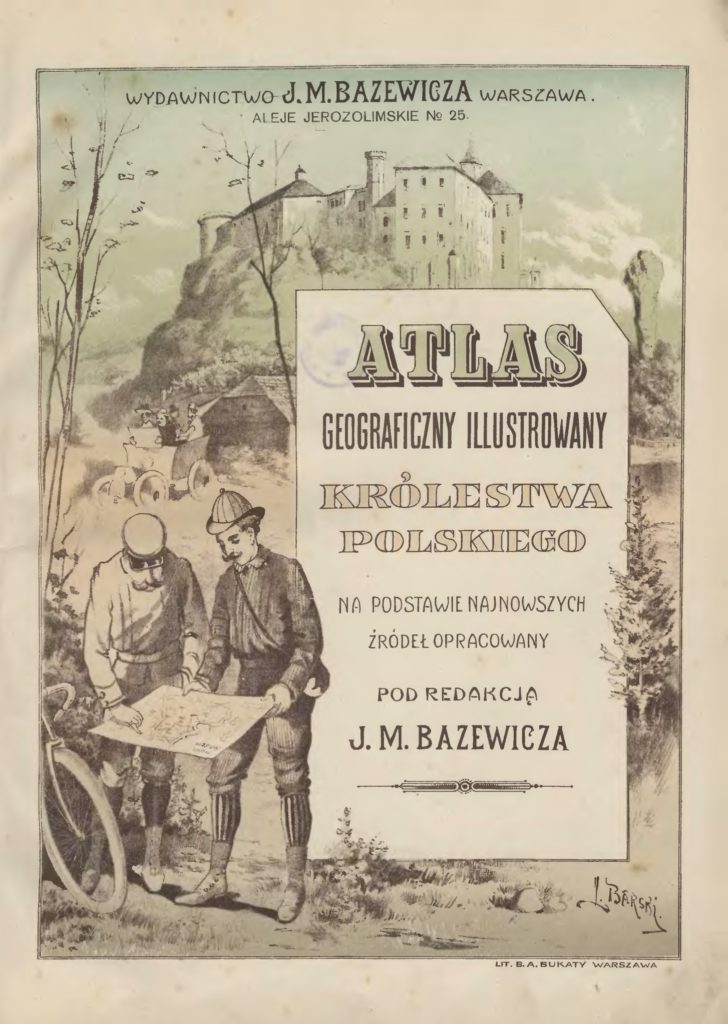The Atlas geograficzny illustrowany Królestwa Polskiego or, in English, The Illustrated Geographic Atlas of the Kingdom of Poland, was published by J. M. Bazewicz in Warsaw in 1907.

Józef Michał Bazewicz, Atlas geograficzny ilustrowany Królestwa Polskiego (Litografia B. A. Bukaty, Warsaw, 1907); digital images, Mapywig(http://igrek.amzp.pl/appendix_cat.php?idapp=1759936&idcat=BAZAKP1907 : accessed 18 February 2019).
Like its cousin, the Słownik geograficzny Królestwa Polskiego i innych krajów słowiańskich (The Geographic Dictionary of the Kingdom of Poland and Other Slavonic Countries), the Atlas geograficzny illustrowany Królestwa Polskiego (The Illustrated Geographic Atlas of the Kingdom of Poland) is a valuable resource for genealogists seeking information on the places in Poland in which their ancestors lived.
Both the Atlas geograficzny illustrowany and the Słownik geograficzny were prepared at the end of the 19th century and beginning of the 20th century and, while the Słownik geograficzny provides information on nearly every village in Poland, it includes no maps or illustrations to show graphically where those villages were located.
The Atlas geograficzny illustrowany includes color maps of the Russian-controlled Kingdom of Poland (or, as it was officially designated by Russia, the Vistulan Country of the Russian Empire) and detailed descriptions of each gubernia, powiat (or okręg) in the country, as well as detailed descriptions of the major cities in each powiat. Only a few cities and villages in each powiat are described. In powiat makowski (gubernia łomżyńska), only five cities and villages are described (Maków, Sieluń, Krasnosielc, Różan, and Szelków), although over 140 cities and villages are named on the map itself.
Finding an original printed copy of the Atlas geograficzny illustrowany is nearly impossible for genealogists in the western hemisphere. Indeed, WorldCat (http://www.worldcat.org/) lists only one library in the world with a copy: Bibliothek Des Herder-Instituts in Marburg, Germany. No doubt, however, one can find original print copies in libraries throughout Poland, but even that’s of limited help for genealogists in the Americas.
The catalog of the Family History Library in Salt Lake City does, however, list seven print copies of the Atlas geograficzny illustrowany, including five copies available, one missing, and one on loan. The Family History Library also lists a copy on microfilm and a copy on microfiche. The copy of the Atlas geograficzny illustrowany (now listed as missing) that once was located on the atlas stand on the international floor (B1) was a photocopy, not an original. Whether the other print copies in the Family History Library are photocopies or originals is not mentioned in the Family History Library catalog.
Despite the apparent scarcity of the original print copies in the Americas, the entire Atlas geograficzny illustrowany Królestwa Polskiego is available in superb resolution online on Mapster, digitized from a copy of the Atlas in the Municipal Public Library in Zabrze.
The Atlas geograficzny illustrowany begins with an index to the color maps and a legend to the symbols that appear in the maps. Small crosses indicate the locations of churches. Horns indicate the location of post offices. Mountains, rivers, marshes, and roads are also shown. The legend to the Atlas includes:
miasto gubern. = provincial city
miasto powiatowe = district city
miasto i osada = city and settlement
wieś kościelna = church village
urząd gminny = local office
wieś = village
urząd pocztowy = post office
rzeka = river
góra = mountain
bagno = swamp
droga zel 1 tor = single lane road
droga zel 2 tor = two lane road
stacia kolejowa = railway station
droga bita = beaten track
gościniec = track
trakt pocztowy = postal road
droga zwyczajna = ordinary way
granica państwa = state border
granica powiatu = district border
odległości pokazane w wiorstach = distances shown in woirsts
The index and legend are followed by the color maps themselves, but these are not just maps. Each map includes illustrations of people, clothing, buildings, and landscapes from the mapped area.
The maps are followed by a message to the readers from the editor (Do Czytelników) and a description of the general features of the Kingdom of Poland (Rys ogólny Królestwa Polskiego), including uplands (wyżyny), rivers (rzeki), lakes (jeziora), and marshes, bogs, and swamps (błota). Other general features include agriculture (rolnictwo), industry (przemysł), commerce (handel), transportation (komunikacya), and church matters and education (sprawy kościelne i oświata). The next section of the Atlas describes historical features of the Kingdom of Poland (Rys historyczny Królestwa Polskiego).
The Atlas geograficzny illustrowany then continues with descriptions of gubernias, powiats, and localities, grouping the localities under the descriptions of the powiats to which they belong, and grouping the powiats under the descriptions of their gubernias.
The final two pages of the Atlas geograficzny illustrowany provide an index to the localities contained in the present work (Skorowidz miejscowości zawartych w niniejszym opisie).
The Atlas geograficzny illustrowany is a wonderful work, illustrating the area of the Kingdom of Poland as it was known at the time of the largest migration of Polish emigrants to the United States and, therefore, describes Poland as the ancestors of most Polish Americans would have remembered it. As such, it is a valuable resource to genealogists and family historians who wish to know how and where their Polish ancestors lived.
Copyright © 2009-2019 by Stephen J. Danko




Steve, Every time I see a reference to your site & your work, I think I ought to ask if your Danko line is the one that intersects my ancestors? My great-uncle James (Vaclaw) Kuszynski married Viola Danko (Oct 1897 – Dec 1984) on Nov. 2, 1939 in Chicago. She was married previously and had Danko children. Just curious, Annie –Thanks for your good work!